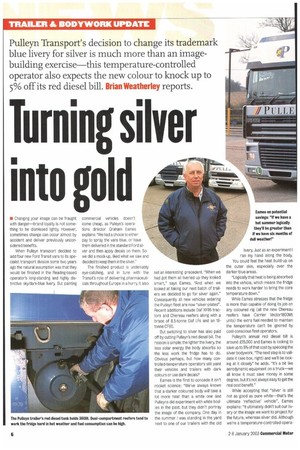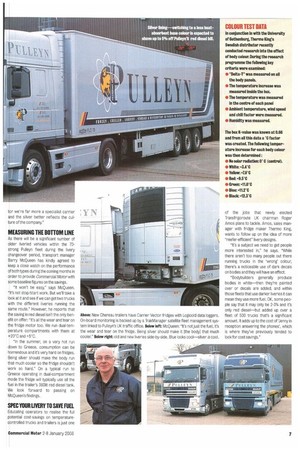Turning silver into gold
Page 6

Page 7

If you've noticed an error in this article please click here to report it so we can fix it.
Pulleyn Transport's decision to change its trademark blue livery for silver is much more than an imagebuilding exercise—this temperature-controlled operator also expects the new colour to knock up to 5% off its red diesel bill. Brian Weatherley reports.
• Changing your image can be fraught With danger—brand loyalty is not something to be dismissed lightly. However, sometimes change can occur almost by accident and deliver previously unconsidered benefits.
When Pulleyn transport decided to add four new Ford Transit vans to Its specialist transport division some two years ago the natural assumption was that they would be finished in the Reading-based operator's long-standing and highly distinctive sky/dark-blue livery. But painting commercial vehicles doesn't come cheap, as Pulleyn's operations director Graham Eames explains: "We had a choice to either pay to spray the vans blue, or have them delivered in the standard Ford silver and then apply decals on them. So we did a mock-up, liked what we saw and decided to keep them in the silver."
The finished product is undeniably eye-catching, and in tune with the Transit's role of delivering pharmaceuticals throughout Europe in a hurry. It also set an interesting precedent. "When we had got them all liveried up they looked smart," says Eames. "And when we looked at taking our next batch of trailers we decided to go for silver again." Consequently all new vehicles entering the Pulleyn fleet are now "silver-plated". Recent additions include Daf XF95 tractors and Chereau reefers along with a brace of 8.5-tonne Oaf LFs and an 18tonne CF65.
But switching to silver has also paid off by cutting Pulleyn's red diesel bill. The reason is simple: the lighter the livery, the less solar energy the body absorbs so the less work the fridge has to do. Obvious perhaps, but how many controlled-temperature operators still paint their vehicles and trailers with dark colours or use dark decals?
Eames is the first to concede it isn't rocket science: "We've always known that a darker coloured body will take a lot more heat than a white one and Pulleyns did experiment with white bodies in the past, but they didn't portray the image of the company. One day in the summer I was standing in the yard next to one of our trailers with the old livery. Just as an experiment I ran my hand along the body. You could feel the heat build-up on the outer skin, especially over the darker blue areas.
"Logically that heat is being absorbed into the vehicle, which means the fridge needs to work harder to bring the core temperature down."
While Eames stresses that the fridge is more than capable of doing its job on any coloured rig (all the new Chereau reefers have Carrier Vector1800Mt units) the extra fuel needed to maintain the temperature can't be ignored by cost-conscious fleet operators.
Pulleyn's annual red diesel bill is around .05,000 and Eames is looking to save up to 5% of that cost by speccing the silver bodywork. "The next step is to validate it (see box, right) and we'll be looking at it closely" he adds. 'it's a bit like aerodynamic equipment on a truck—we all know it must save money in some degree, but it's not always easy to get the real cost benefit."
While accepting that "silver is still not as good as pure white—that's the ultimate 'reflective' vehicle", Eames explains: "It ultimately didn't suit our livery or the image we want to project for the future, whereas silver did. Although we're a temperature-controlled opera tor we're far more a specialist carrier and the silver better reflects the culture of the company."
MEASURING THE BOTTOM LINE
As there will be a significant number of older liveried vehicles within the 70strong Pulleyn fleet during the livery changeover period, transport manager Barry McQueen has kindly agreed to keep a close watch on the performance of both types during the coming months in order to provide Commercial Motor with some baseline figures on the savings.
"It won't be easy," says McQueen. "It's not stop/start work. But we'll take a look at it and see if we can get two trucks with the different liveries running the same route." However, he reports that the saving in red diesel isn't the only benefit on offer: "It's all the wear and tear on the fridge motor too. We run dual-temperature compartments with them at +20°C and +5°C "In the summer, on a very hot run down to Greece, consumption can be horrendous and it's very hard on fridges. Being silver should make the body run that much cooler so the fridge shouldn't work so hard." On a typical run to Greece operating in dual-compartment mode the fridge will typically use all the fuel in the trailer's 3601it red diesel tank. We look forward to passing on McQueen's findings.
SPEC YOUR LIVERY TO SAYE FUEL
Educating operators to realise the full potential cost-savings on temperaturecontrolled trucks and trailers is just one
of the jobs that newly elected Transfrigoroute UK chairman Roger Amos plans to tackle. Amos, sales manager with fridge maker Thermo King, wants to follow up on the idea of more "reefer-efficient" livery designs.
"It's a subject we need to get people more interested in," he says. "While there aren't too many people out there running trucks in the 'wrong' colour, there's a noticeable use of dark decals on bodies and they will have an effect.
"Bodybuilders generally produce bodies in white—then they're painted over or decals are added, and within those fleets that use darker liveries it can mean they use more fuel. OK, some people say that it may only be 2-3% and it's only red diesel—but added up over a fleet of 500 trucks that's a significant amount. It adds up to the cost of 'Jenny in reception answering the phones', which is where they've previously tended to look for cost savings."
































































































































